Do you have a question about the Panasonic Viera TX-L47ET5E and is the answer not in the manual?
Instructions for safely handling the power plug and lead to prevent electrical hazards and fire.
Specifies the TV's power source requirements and essential installation considerations.
Discusses precautions regarding radio waves from the TV and potential interference with medical equipment.
Explains the usage and considerations for the TV's built-in wireless LAN feature for network connectivity.
Lists the items included in the TV package as standard accessories such as remote control and cables.
Details on purchasing and installing a wall-hanging bracket for the TV, including screw specifications.
Information about the optional Communication Camera accessory for video calls and other features.
Details of the TV's remote control buttons and their corresponding functions for operation.
Explains the TV's indicator lights (Power/Timer LED) and physical control panel buttons.
Identifies and describes the various connection terminals available on the TV for external devices.
Guides on connecting the TV's mains lead and aerial for power and reception.
Illustrates how to connect external AV devices like DVD players and set-top boxes using various cables.
Instructions for setting up wired and wireless network connections for the TV's online features.
Step-by-step guide to automatically search and tune TV channels, select language, country, and mode.
Guides on establishing the TV's network connection for online services, including wired and wireless options.
Explains wireless connection methods like WPS for network setup and encryption key input.
Guides on turning on the TV, selecting viewing modes, and choosing channels via remote or list.
Explains how to display and interpret the TV's information banner showing channel and program details.
Details on setting the Off Timer for automatic standby and adjusting the picture aspect ratio.
Guides on accessing and navigating the Electronic Programme Guide (EPG) for program listings.
Instructions for viewing program details and advertisements through the GUIDE Plus+ system.
How to set programs to watch or record using the timer function for DVB broadcasts.
Guides on accessing teletext mode, navigating pages, and using basic functions like HOLD and INDEX.
Explains different teletext display modes (TOP, BOTTOM) and features like multi-window and storing pages.
How to select the correct input source (AV, HDMI, PC) for external equipment connected to the TV.
Guides on operating connected external equipment's functions using the TV's remote control.
Important safety and usage instructions for 3D eyewear and viewing 3D content.
Guides on viewing 3D images from various sources and converting 2D content to 3D.
Detailed settings for adjusting 3D image depth, detection, signal message, and safety precautions.
Guides on displaying feature icons and selecting functions like VIERA Link, Photo, Video, Music, and Media Server.
Settings for image quality, viewing modes, color balance, vivid color, eco mode, and noise reduction.
Options for sound modes, bass, treble, equalizer, balance, surround, and audio output settings.
Configuration of network connections, software updates, and network status.
Various setup options including link settings, eco navigation, child lock, language, and display preferences.
Step-by-step guide to automatically retune TV channels using the setup menu or TV buttons.
Guides on creating and managing favourite channel lists for DVB broadcasts.
Instructions for skipping channels, editing lists, renaming channels, and manually tuning channels.
Procedures for updating channel lists and checking DVB signal conditions.
Guides on accessing the timer menu and setting up recording or reminder events for DVB programs.
Detailed steps for specifying channel, date, time, and subtitle options for timer programming.
Guides on locking specific channels or inputs for parental control and managing access.
Instructions for changing the Child Lock PIN and setting parental rating restrictions based on program suitability.
Guides on setting up and enabling interactive data services like Hybrid Broadcast Broadband TV (HbbTV).
Guides on inserting the CI module and accessing its functions for encrypted content viewing.
Guides on restoring the TV to its original factory settings, erasing all configurations and channels.
Guides on performing automatic or manual software updates for the TV to enhance performance.
Guides on connecting a PC and adjusting display settings for optimal viewing on the TV screen.
Detailed guides for fine-tuning picture quality via advanced settings like white balance, color, and gamma.
Instructions for inserting and removing SD cards and USB flash drives for media playback.
Guides on navigating, selecting, and playing photos, videos, and music files from connected media.
Settings for photo slideshows, video playback options, and music playback preferences.
How to create 3D photos from pairs of images using the TV's Multi Shot 3D function.
How to share and enjoy media content across a home network using DLNA features.
Accessing internet services and applications via the VIERA Connect portal.
Guides on connecting the TV to wired or wireless networks and configuring network settings.
Using Q-Link for easy recording and playback with DVD recorders/VCRs via SCART connection.
Utilizing VIERA Link for HDMI-connected equipment control, recording, and home theater setup.
Guides on directly recording programs to a recorder and pausing live TV broadcasts.
Features for power saving, auto standby, and selecting audio output options.
How to operate connected equipment's menus using the TV remote via VIERA Link.
Illustrates connections for DVDs, USB devices, HDMI equipment, speakers, and PCs.
A table detailing connectable equipment for each TV terminal type (AV, HDMI, USB, etc.).
Details on auto aspect ratio adjustment and PC connection signals and resolutions.
Lists supported file formats for photos, videos, and music playback via Media Player.
Information on HDMI/USB connections, DivX playback, subtitles, and VOD registration.
Table detailing compatible input signals and resolutions for various TV terminals.
Troubleshooting common issues related to picture quality, signal reception, and display.
Solutions for sound problems and difficulties viewing 3D content.
Troubleshooting connectivity problems with external devices, networks, and linked functions.
Solutions for common TV operation problems like power, remote control, and error messages.
Procedures for cleaning the display panel, cabinet, and pedestal using soft cloths.
Lists software and technologies incorporated into the product, including licensing details and terms.
Details on TV model numbers, dimensions, and weight for different screen sizes.
Technical specifications for power, audio, connectivity terminals, wireless, and 3D eyewear.
Instructions for safely handling the power plug and lead to prevent electrical hazards and fire.
Specifies the TV's power source requirements and essential installation considerations.
Discusses precautions regarding radio waves from the TV and potential interference with medical equipment.
Explains the usage and considerations for the TV's built-in wireless LAN feature for network connectivity.
Lists the items included in the TV package as standard accessories such as remote control and cables.
Details on purchasing and installing a wall-hanging bracket for the TV, including screw specifications.
Information about the optional Communication Camera accessory for video calls and other features.
Details of the TV's remote control buttons and their corresponding functions for operation.
Explains the TV's indicator lights (Power/Timer LED) and physical control panel buttons.
Identifies and describes the various connection terminals available on the TV for external devices.
Guides on connecting the TV's mains lead and aerial for power and reception.
Illustrates how to connect external AV devices like DVD players and set-top boxes using various cables.
Instructions for setting up wired and wireless network connections for the TV's online features.
Step-by-step guide to automatically search and tune TV channels, select language, country, and mode.
Guides on establishing the TV's network connection for online services, including wired and wireless options.
Explains wireless connection methods like WPS for network setup and encryption key input.
Guides on turning on the TV, selecting viewing modes, and choosing channels via remote or list.
Explains how to display and interpret the TV's information banner showing channel and program details.
Details on setting the Off Timer for automatic standby and adjusting the picture aspect ratio.
Guides on accessing and navigating the Electronic Programme Guide (EPG) for program listings.
Instructions for viewing program details and advertisements through the GUIDE Plus+ system.
How to set programs to watch or record using the timer function for DVB broadcasts.
Guides on accessing teletext mode, navigating pages, and using basic functions like HOLD and INDEX.
Explains different teletext display modes (TOP, BOTTOM) and features like multi-window and storing pages.
How to select the correct input source (AV, HDMI, PC) for external equipment connected to the TV.
Guides on operating connected external equipment's functions using the TV's remote control.
Important safety and usage instructions for 3D eyewear and viewing 3D content.
Guides on viewing 3D images from various sources and converting 2D content to 3D.
Detailed settings for adjusting 3D image depth, detection, signal message, and safety precautions.
Guides on displaying feature icons and selecting functions like VIERA Link, Photo, Video, Music, and Media Server.
Settings for image quality, viewing modes, color balance, vivid color, eco mode, and noise reduction.
Options for sound modes, bass, treble, equalizer, balance, surround, and audio output settings.
Configuration of network connections, software updates, and network status.
Various setup options including link settings, eco navigation, child lock, language, and display preferences.
Step-by-step guide to automatically retune TV channels using the setup menu or TV buttons.
Guides on creating and managing favourite channel lists for DVB broadcasts.
Instructions for skipping channels, editing lists, renaming channels, and manually tuning channels.
Procedures for updating channel lists and checking DVB signal conditions.
Guides on accessing the timer menu and setting up recording or reminder events for DVB programs.
Detailed steps for specifying channel, date, time, and subtitle options for timer programming.
Guides on locking specific channels or inputs for parental control and managing access.
Instructions for changing the Child Lock PIN and setting parental rating restrictions based on program suitability.
Guides on setting up and enabling interactive data services like Hybrid Broadcast Broadband TV (HbbTV).
Guides on inserting the CI module and accessing its functions for encrypted content viewing.
Guides on restoring the TV to its original factory settings, erasing all configurations and channels.
Guides on performing automatic or manual software updates for the TV to enhance performance.
Guides on connecting a PC and adjusting display settings for optimal viewing on the TV screen.
Detailed guides for fine-tuning picture quality via advanced settings like white balance, color, and gamma.
Instructions for inserting and removing SD cards and USB flash drives for media playback.
Guides on navigating, selecting, and playing photos, videos, and music files from connected media.
Settings for photo slideshows, video playback options, and music playback preferences.
How to create 3D photos from pairs of images using the TV's Multi Shot 3D function.
How to share and enjoy media content across a home network using DLNA features.
Accessing internet services and applications via the VIERA Connect portal.
Guides on connecting the TV to wired or wireless networks and configuring network settings.
Using Q-Link for easy recording and playback with DVD recorders/VCRs via SCART connection.
Utilizing VIERA Link for HDMI-connected equipment control, recording, and home theater setup.
Guides on directly recording programs to a recorder and pausing live TV broadcasts.
Features for power saving, auto standby, and selecting audio output options.
How to operate connected equipment's menus using the TV remote via VIERA Link.
Illustrates connections for DVDs, USB devices, HDMI equipment, speakers, and PCs.
A table detailing connectable equipment for each TV terminal type (AV, HDMI, USB, etc.).
Details on auto aspect ratio adjustment and PC connection signals and resolutions.
Lists supported file formats for photos, videos, and music playback via Media Player.
Information on HDMI/USB connections, DivX playback, subtitles, and VOD registration.
Table detailing compatible input signals and resolutions for various TV terminals.
Troubleshooting common issues related to picture quality, signal reception, and display.
Solutions for sound problems and difficulties viewing 3D content.
Troubleshooting connectivity problems with external devices, networks, and linked functions.
Solutions for common TV operation problems like power, remote control, and error messages.
Procedures for cleaning the display panel, cabinet, and pedestal using soft cloths.
Lists software and technologies incorporated into the product, including licensing details and terms.
Details on TV model numbers, dimensions, and weight for different screen sizes.
Technical specifications for power, audio, connectivity terminals, wireless, and 3D eyewear.

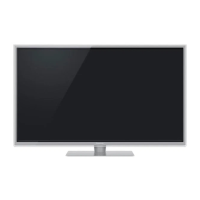
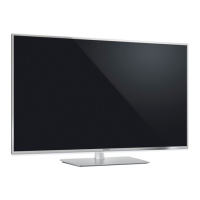






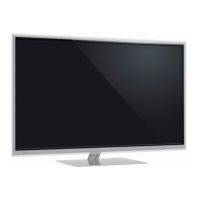
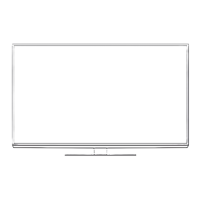
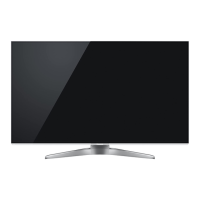
